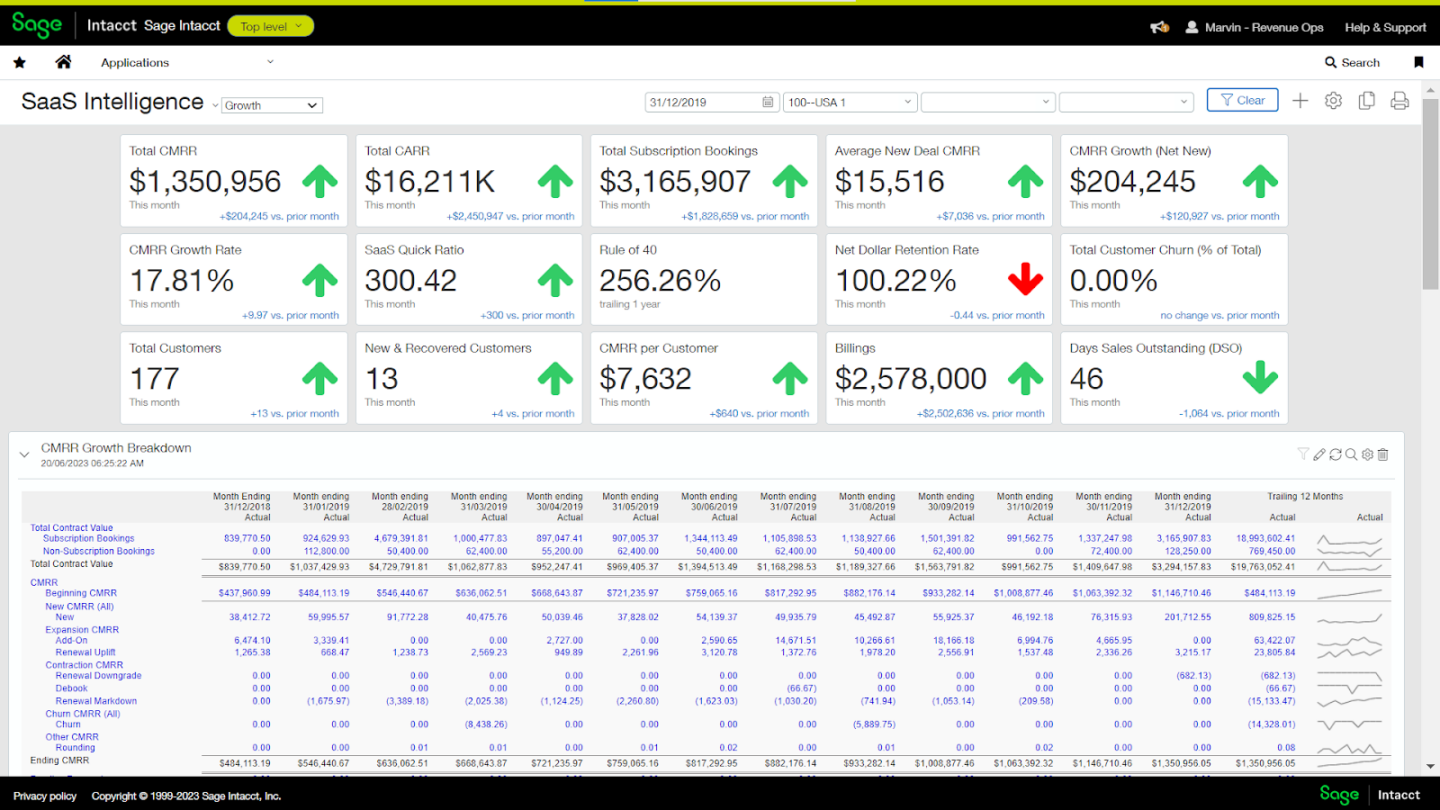A CFO’s guide to SaaS customer engagement metrics
Learn how to gauge the success of your SaaS business with customer engagement metrics. Our guide offers insights and strategies for CFOs

Are you struggling to keep your SaaS customers hooked? Do you want to know how to measure and improve their engagement? Look no further than this guide to SaaS customer engagement metrics. In this post, we’ll dive deep into customer engagement metrics for software companies. What are they, why do they matter, and how do they fit into your company’s broader financial success?
We’ll also provide actionable tips on how to improve your overall customer engagement so you can retain loyal customers and win your market. Let’s get started.
Understanding SaaS customer engagement metrics
Metrics are crucial for evaluating user engagement in the SaaS industry. They give you actionable insights into how your customers are interacting with your products.
Recurring revenue companies depend on high levels of customer engagement. If you can’t keep your customers hooked through superior service, your business growth will eventually plateau, and you might even start to experience high churn levels.

By utilizing customer engagement metrics, you can effectively assess the success of your SaaS company. Proactively tracking customer engagement is essential because it directly impacts the profitability of your SaaS business model–much more on this in a moment.
You might be tempted to think that customer engagement metrics primarily concern the accounting department at your company. After all, tracking financial metrics falls to the finance team. And in that basic sense, you’re right. But your engagement metrics should be a top priority for everyone.
To name just a handful of departments impacted by customer engagement, you’ve got:
- Sales: Customer engagement data gives the sales team vital feedback about users’ experiences and brand-related sticking points. With this information, your sales team can fine-tune their approach for higher closing rates.
- Marketing: Your company’s marketing funnel and supporting assets (your blog, client resource center, etc.) lay the groundwork for seamless user onboarding. Similarly to sales, supplying engagement data to marketing stakeholders enables them to craft campaigns that drive eager onboarding and lasting revenue through user engagement.
- Customer success: Customer success is pivotal in smoothing out customers’ problems before they get fed up and churn. The more quickly you can identify dissatisfied customers and refer them to customer success for outreach, the higher your revenue will likely be. Your customer engagement metrics facilitate that process.
Now that you know more about customer success metrics and their relevance for SaaS organizations, let’s look at why tracking them diligently is so important.
Importance of tracking customer engagement metrics in SaaS
Tracking customer engagement metrics in SaaS is essential for gaining insights into user behavior, which is the root of all revenue. By monitoring the metrics we’ll be covering, you’ll have a real-time understanding of your customers’ collective behavior.
What are they doing that they shouldn’t be–churning, perhaps? What aren’t they doing that you’d like them to, such as upgrading their subscription tier?
Understanding customer engagement metrics helps you give your customers the experience they want from your product. By tracking metrics such as the number of customers, monthly recurring revenue (MRR), and average revenue per user (ARPU), you can assess your customer base’s health, satisfaction, and growth.

In a competitive market, tracking customer engagement metrics is vital for staying ahead of your competition. Analyzing metrics like your monthly number of customer service interactions, social media mentions, and total monthly product usage can give you a better understanding of whether your products meet customer needs and expectations. These insights can inform product development and help you tailor your offerings to meet customer expectations.
Now, on to the main event. Which metrics should you rely on to track customer engagement across time? And what does your company stand to gain from these important datapoints?
Key SaaS customer engagement metrics
By monitoring these SaaS customer engagement metrics, you can gain a much deeper understanding of your customer base, make informed decisions about product development and growth potential, and optimize your financial planning and analysis (FP&A) to improve customer retention and satisfaction.
Let’s dive in.
Daily active users (DAU) and monthly active users (MAU)
Measuring your number of active users within a specific time period is considered a universal best practice for SaaS. Both daily active users (DAU) and monthly active users (MAU) play a crucial role in understanding user engagement in the SaaS industry.
Tracking these metrics gives you valuable insights into user behavior and usage patterns over time. DAU measures the number of unique individuals who engage with a product or service daily, while MAU provides a broader picture by measuring the number of active users within a month.
Be especially mindful of your DAU to MAU ratio, or how your daily user figures compare to your monthly user rates. The more closely aligned the numbers are, the better. A low DAU paired with a high MAU signifies that you have many monthly users, but your overall engagement is lower than it should be.
With the rise of SaaS recurring revenue business models, tracking DAU and MAU has become essential for SaaS companies to monitor and improve customer engagement and retention rates.
Customer engagement score (CES)
Your CES is a metric that quantifies your customers’ level of engagement and satisfaction. It indicates how loyal your customers may or may not be and how likely they are to remain long-term users.
You can calculate your CES in 4 simple steps:
1. Identify the product events you want to measure, such as customer onboarding, account upgrades, cross-sells, successful customer service interactions, etc.
2. Assign each of these events a weighted score.
3. Multiply each event’s weighted score by that event’s total number of occurrences to arrive at an event value.
4. You can now find the total engagement score of each customer by adding all the event values for each customer together. Cloud accounting software can perform tasks like this instantly, helping you maintain awareness of customers’ behavior.
A higher CES score implies that your customers are more satisfied and engaged, which is crucial for the success of your SaaS business. It indicates that your customers are likely to stay with your product or service, renew their subscriptions, and even become promoters of your brand, which is what our next metric is all about.
Net promoter score (NPS)
Your NPS measures the loyalty of your customers and their likelihood to recommend your product to others. By monitoring NPS, businesses can gain insights into the satisfaction and loyalty levels of their customer base. NPS helps you identify customer promoters, who actively recommend the product or service to others and detractors who would not, and who might even leave you a poor review.
Tracking your NPS matters significantly. In the age of online reviews, where user complaints can be front and center for prospective customers, your NPS allows you to proactively conduct reputation management. If your data has identified customer segments with a particularly high NPS, you might try incentivizing them to leave positive reviews or social media mentions. A consistently low NPS means you have some work to do on your product or UX.
Calculating your NPS is pretty straightforward. You simply send out a survey to all users asking some version of, “How likely are you to recommend our product to others?” They then reply on a 1-10 scale, after which you total up all scores from the individuals who replied.
So for example, say you received 250 responses. When you add them up, the total score comes to 1,875 out of 2,500. That translates to an NPS of 7.5.
Survey applicants fall into three categories: detractors, passive, or promoters. Detractors are the people who replied somewhere between 1 and 6. Passive customers will give you a 7 or 8. And your promoters responded with either a 9 or 10.
For Saas CFOs, your NPS is particularly crucial in understanding customer sentiment and improving the overall customer experience.
It’s a good idea to send out NPS surveys at least quarterly so you can track improvements, or see if you’re starting to slip.
Customer churn rate
Customer churn (also called logo churn) is a crucial metric that measures the percentage of customers lost over a specific period. It serves as a valuable tool for gauging your customer retention rates and user satisfaction.
To calculate churn, simply divide the number of users who unsubscribed over a given period by your total number of customers for that same timeframe, and multiply your answer by 100. For benchmarking purposes, the average monthly churn rate for SaaS companies is between 3% and 8%.

A lower churn rate indicates higher customer loyalty and engagement, while a higher churn rate may signal potential issues with your product performance, customer service, product-market fit, or something else.
Be mindful that there are two types of churn. Voluntary churn, or logo churn, occurs when a user purposely unsubscribed from your product.
Involuntary churn is when a user gets kicked off their subscription because their credit card fails to process. Accounting automation can help you stay vigilant about both types of churn to maximize revenue and engagement.
Revenue churn rate
Revenue churn tells you the total amount of lost revenue from customer churn for a certain period. Distinguishing between logo churn and revenue churn is important because it gives you insight into your customers’ relative loyalty and buying patterns.
For example, say you’re looking over your metrics and you notice that customer churn over a given month was low, but revenue churn spiked in that same month. That would indicate that you lost some of your more loyal customers since they accounted for more than the average share of revenue per customer. Otherwise, your low customer churn rate for that month would be matched by a low revenue churn rate.
Taken together, revenue and logo churn help you identify whether your business is retaining its customer base and whether you’re converting that retention into long-term customer loyalty.
2 SaaS acquisition metrics to monitor
Customer success metrics are invaluable for SaaS companies. But when you combine them with acquisition metrics, they become even more instructive for finance leaders. As the name suggests, your acquisition metrics tell you how effectively you onboard new customers.
Below are two of the most important acquisition metrics for SaaS CFOs to track and optimize.
Customer acquisition cost (CAC)
Your company’s customer acquisition cost (CAC) tells you the amount of money you need to spend to acquire a new customer. You can calculate it in three simple steps:
1. Add up all the money your company spent on sales and marketing activities for the period of time you’re analyzing.
2. Tally up all the customers you gained in that same period.
3. Divide the first number by the second, and you’ll have the dollar amount of your CAC.
Lowering your CAC is crucial as it increases your general profitability and boosts the cash you have available for business reinvestment. By improving factors such as customer service quality, email campaign performance, and sales closing rates, companies can enhance their CAC and drive better outcomes.
Lead-to-customer conversion rate
Your company’s lead-to-customer conversion rate is a crucial metric that measures the percentage of leads you successfully convert into paying customers. By improving their conversion rate, SaaS businesses can experience significant revenue growth and enhance their bottom line.
Tracking your lead-to-customer conversion numbers allows you to identify areas for improvement within your sales funnel. Sales funnels have multiple touchpoints, ranging from the discovery phase to exploration and eventually through to purchasing. So if your lead-to-customer conversion rate isn’t all it could be, odds are decent that there’s a bottleneck in your funnel.
This acquisition metric is closely tied to CAC, and they directly influence one another. The goal is to pair a low CAC with the highest possible lead-to-customer conversion rate.
2 SaaS retention metrics you should be watching
For recurring revenue organizations, your focus needs to be equally spread across customer acquisition and retention.
If you’re not retaining customers, you’ll have a hard time achieving positive cash flow, making it much more difficult to invest in product development, boost sales and marketing initiatives, or attract investor capital.
Below are two of the most important retention metrics for SaaS CFOs to keep an eye on.
Customer lifetime value (CLTV)
Your CLV is a crucial metric for measuring the value of your customer base over time. CLTV represents the total revenue a customer is expected to generate throughout their relationship with your business.
By tracking your CLTV with automated accounting software, you can easily evaluate the satisfaction of different segments of your customer base. This has two strategic advantages associated with it:
1. You’ll be better able to identify and fix whatever problems your low-satisfaction (low CLTV) customers are experiencing.
2. You can double down on your most profitable segments and make even more money.
CLTV is calculated by multiplying your ARPU by the average customer lifespan. This metric provides valuable insights into the growth potential of your SaaS business and helps you allocate resources effectively.
To calculate CLTV accurately, businesses need reliable data on customer behavior, such as purchase history, renewal rates, and average revenue per customer. Cloud-based analytics tools can provide crystal clarity into both your acquisition and retention metrics.
We have one more retention metric to cover, and then we’ll close out with a brief discussion about improving your engagement metrics.
Retention rate
Retention rate is a crucial customer engagement metric for SaaS businesses. It measures the percentage of customers who subscribe or renew their subscriptions over a specific period. As the CFO of a recurring revenue business, your retention rate is extraordinarily important.
To calculate it for a given period, simply divide your beginning number of users for that timeframe by the number who renewed their subscription to your product.
Be mindful that none of these metrics exist in a vacuum. They’re all related to one another and influence one another. For instance, improving your retention rate is essential because it increases your CLV and overall cash flow. By the same token, a high retention rate correlates to a low churn rate and a higher customer engagement score.
How can SaaS companies improve their customer engagement metrics? 5 tips
Today’s SaaS market has grown more competitive than ever, making it imperative for companies to give themselves an advantage wherever possible.
Below are 5 of our top tips for accomplishing that:
- Boost user engagement and satisfaction by enhancing product functionality and user experience.
- Implement effective customer relationship management strategies to build strong personal connections.
- Segment and personalize your marketing campaigns for increased engagement.
- Provide exceptional customer support for improved user satisfaction.
- Eliminate data silos with an SSOT. This allows you to eliminate accounting lag and access real-time SaaS metrics 24/7.
Tracking your customer engagement metrics is crucial, but it’s not enough on its own. You need to pay attention to your tech stack and whether it features real-time integration with all the metrics you need to gauge your company’s success.
Discover 9 vital subscription metrics
For subscription SaaS companies, your metrics and KPIs offer a pivotally important touchpoint, giving you objective data you can trust to help you win your market. However, there are dozens of metrics available to SaaS CFOs, making the sheer number of KPIs at your disposal a bit overwhelming.
Our recent ebook spotlights 9 of the most important metrics that subscription and SaaS companies can use to monitor their success. You can read it here.
9 key SaaS and subscription metrics to understand portfolio company health (reference only)
Learn these 9 indispensable metrics that shed light on the performance and profitability of SaaS and subscription-based businesses.







Ask the author a question or share your advice